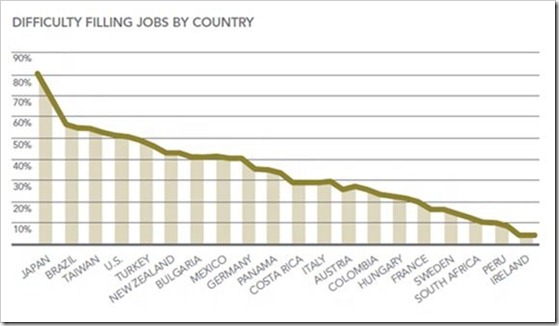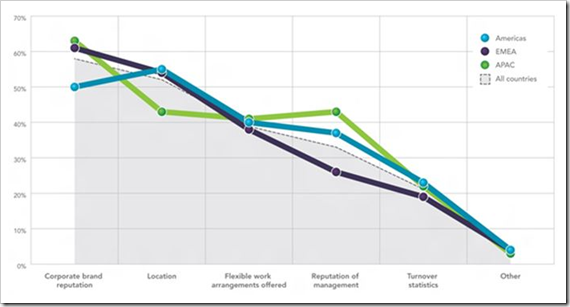Attracting, Retaining and Managing Talent: Challenges & Solution [Kelly OCG]
Attracting, retaining and managing top talent is arguably among the highest concerns of ambitious companies. This was precisely the subject of a webcast presented by Kelly OCG, a leading firm that focuses on talent management solutions. I was fortunate to attend it, and this post will put down some of the points discussed during that webcast.
The 2012 Kelly Global Workforce Index paints a dismal picture of the minds of most workers — there’s a general feeling of being under-valued, with many of them think of resigning from their current jobs.
Kelly OCG’s assessment highlights that employees around the world are restless, and like never before, are face to face with economic difficulties. The firm advises focusing on brand recognition and corporate culture to improve an employer’s perception in the job market.
The presenter of the webcast was Teresa Carroll, SVP at the Centers of Excellence for Kelly Services and GM of Kelly OCG.
Contents
What Businesses Think about Talent
When Kelly surveyed CEO’s during 2011 to ascertain their top business concerns, talent management appeared at the number one position, up from number three the previous year. The next three concerns were navigating risk, innovation and leadership development, which Ms Carroll explains were linked to talent management as well.
Two-thirds of CEO’s say they will formally include risk scenarios into their strategic planning, and nearly three-quarters of them say they will spend more senior management time to address risk. Ms Carroll explains that the involvement of senior management time in such situations calls for an assessment of talent, and the risks associated with it.
Innovation
78% of CEO’s are reported to expect their development efforts to generate significant new revenue opportunities in the coming three years. 79% believe innovation will lead to competitive advantage and 84% of CEO’s have changed strategies in the past two years. Ms Carroll emphasizes that companies can attract talent as long as they can effectively communicate their strategy to the brains they need on board.
"It’s a hard job for the HR department to explain to new candidates or current employees what the company’s strategy is if it’s changing fairly rapidly in the last few years", says Ms Carroll.
Good Leadership

Ms Carroll highlights how difficult it is for many countries to fill jobs. While Japan, Brazil, Taiwan and the United States lead the list of "difficult" countries, Europe appears to finds it relatively easy to fill jobs largely because of the ongoing economic trouble there. "The types of jobs and skills available in these countries are driving those numbers as well", adds Ms Carroll.
What do Employees Think?
About 35,000 employees were surveyed globally by Kelly OCG to draw conclusions about the subject of talent.
The top three factors that employees in the Asia Pacific region considered before joining a company were the corporate brand reputation, reputation of management and location.

These are the top driving factors to prefer one job over another, with the percentage of employees favoring them:
- Personal fulfillment and work-life balance : 39%
- Personal growth and advancement : 36%
- Compensation and benefits: 19%
The same parameters were measured in terms of three different generations, the Baby Boomers, Gen X and Gen Y, with these results:
Baby Boomers:
- Personal fulfillment and work-life balance : 48%
- Personal growth and advancement : 25%
- Compensation and benefits: 19%
Gen X:
- Personal fulfillment and work-life balance : 41%
- Personal growth and advancement : 34%
- Compensation and benefits: 19%
Gen Y:
- Personal fulfillment and work-life balance : 34%
- Personal growth and advancement : 41%
- Compensation and benefits: 20%
Ms Carroll suggests facilitating telecommuting and greater rotation of employees through jobs within a company.
Are you valued by your current employer?
51% of people surveyed in the Asia-Pacific region said yes, a little above the average for all countries which stands at 44%.
However, 39% are frequently thinking about leaving their current jobs and 60% intend to look for a new job within a year. The global figures for these parameters are 37% and 66% respectively. The top three reasons for this phenomenon in the Asia Pacific region, explains Ms Carroll, were the lack of opportunities for advancement, poor management and poor salaries/benefits.
Here’s what business can focus on to combat talent pressures
1. Talent development
The presenter suggests a holistic look at the complete talent supply chain, and also looking at pools of talent. Ms Carroll hints at using flexible ways to getting work done from employees, as against full time work.
2. Talent engagement and retention.
The presenter says she has personally benefitted from rotating jobs at her company, taking up different roles every couple of years, finally ending up with a job that lets her see Kelly OCG "from all angles and all the operations and staff groups", which has factored in her retention in the company.
3. Talent mobility
Ms Carroll explains that technology has made it possible for employees to work remotely in an unprecedentedly easy fashion, and the question is about how much employers have allowed that aspect in their companies yet to retain their talent.
In fact, 59% of respondents in the survey believed telecommuting is a good option for retention.
"I often say to my customers, at this point, if you want a really good SAP programmer because they are so in demand, if that programmer wants to work on a beach in Tahiti, you might have to send the work in Tahiti ", says Ms Carroll.
According to Ms Carroll, a new approach is needed to hire and retain talent, since the traditional model of acquiring college graduates and expecting them to stay at the company for thirty years and then retire has been completely broken in every region.
The new approach could involve looking at the supply and demand of talent, and look for ways to procure that talent based on the way they want to work. This could apply to the internal talent as well, to counter turnover at the organization.
The Talent Supply Chain Management
The concept of a talent supply chain management was introduced in the webinar. HR individuals could have a talent supply chain manager, as opposed to the traditional talent acquisition manager. An analogy of oil companies that go about exploring vast tracts of territory in search of scarcely available oil is presented — talent has to be accessed in a similar way by uncovering ways using the supply chain.

‘Demand for talent is hard to predict’
The talent supply chain is described with the help of four quadrants, starting with the statement that the demand for talent is hard to predict.
Five decades ago, talent acquisition equations were drawn by determining the number of employees retiring and the volume of goods and services slated to be produced.
Product markets today are extremely unpredictable and such equations are no longer possible. A "just-in-time" demand forecasting is the need of the hour, as explained in the webinar. This is emphasized as reasonable because of its short term accuracy.
The supply of talent is as variable as the demand, according to Ms Carroll.
"We’re seeing the reality that talent works the way they want", she states. "If one day they want to be an independent contractor or consultant, the next day they want to be a full time employee and the day after that they want to be a temporary employee. They actually switch categories of the type of worker they are more than ever before".
Looking at only permanent employees to fulfill talent needs may result in "missing out on a whole population of talent".
Matching demand and supply of talent is a very hard job, and is made worse by prevailing regulations — this is what the bottom right quadrant is all about. In most cases, CEO’s demand that matching of demand and supply of talent is done with costs in consideration.
In the quest for acquiring the right talent, professionals fail to win the war for talent that is set by hiring managers, the subject of the upper right quadrant.
"Hiring managers have a business strategy to execute, and the best way they can execute that is through the best talent on the market", in the words of Ms Carroll. She explains that while they do care about costs and regulations, they are more concerned about winning the war for talent.
Industry Trends
There is an increasing trend of companies turning to dedicated firms, including Kelly OCG, to manage their contingent labor suppliers under MSP’s (Managed Service Programs). This makes up for nearly 50% of all companies now.
RPO (Recruitment Process Outsourcing) is another growing trend that involves turning over full-time hiring to other companies. Close to 40% of companies have adopted this method till date, a figure which is up from 20% in 2007.
Both these aspects can be brought together in a talent supply chain management program. Doing so will allow a holistic view of all categories of talent and help improve decision making.
This diagram shared by Kelly OCG describes the model they have introduced to the industry.

The conclusion is that if a company had operations, human resources and procurement working out a talent strategy and functioning in one holistic talent supply chain with the right analytics, a strategic workforce planning process can be driven to help build the talent strategy.
